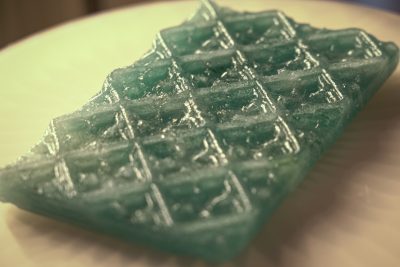Artist shells out on decorative glass tiles

An artist who creates luxury products from waste materials has produced a collection of glass tiles using mussel shells.
Lulu Harrison, a master’s student at London’s Central Saint Martins college, collaborated with architecture studio Bureau de Change and Thames Water to make cladding tiles using shells of invasive quagga mussels removed from London’s water network.
Since 2006, Thames Water has spent around £4 million clearing the mussels, which latch on to the inside of pipes and tunnels and can cause damaging and costly blockages. In using the shells as a raw material to produce bio-glass, Harrison has developed a sustainable alternative to sending them to landfill.
"Thames Water are providing the mussel shells which act as one of the key components of our glass, and would otherwise end up in landfill."
Named Thames Glass, the material is produced using a mixture of ground-up mussel shells, sands from around the River Thames, and waste wood ash to replace the highly processed and uneconomic materials that often go into everyday glassmaking. Each tile is handmade and unique in appearance, with delicate patterns reflecting the designs of terracotta chimney pots created in the mid 19th century by ceramics manufacturer Royal Doulton.
It is a little known fact that the Doulton pottery company, which was based in Lambeth, also produced stoneware pipes that improved London's water and sanitation systems, along with ceramic water filters.

The pieces were displayed during London Craft Week in May 2022.
Lulu Harrison said, “The exhibition was curated by Here Design to demonstrate how innovation in the biosphere can light the path to a more sustainable future.
“Throughout this process, I have become interested in finding alternatives to the highly processed and unsustainable materials often used in glassmaking, and creating a geo-specific glass from materials which are distinctive to a certain area. Through incorporating 21st century waste materials into glassmaking, this project represents the idea of future archaeology, and rethinking the way we view glass, and waste today.
“We have been working alongside Thames Water who are providing us with the quagga mussel shells, which act as one of the key components of our glass, and would otherwise end up in landfill. The project explores ways of working with invasive species and to help restore local biodiversity. “
Lulu, a self-taught glass artist and specialist in glass alchemy, is a second year MA Material Futures student. In making Thames Glass, she has been working alongside glass masters in the UK and Italy, as well as professors in glass archaeology. She says by combining crafts, design and science, she is seeking to redefine the meaning of luxury, through working with waste materials and local communities.
